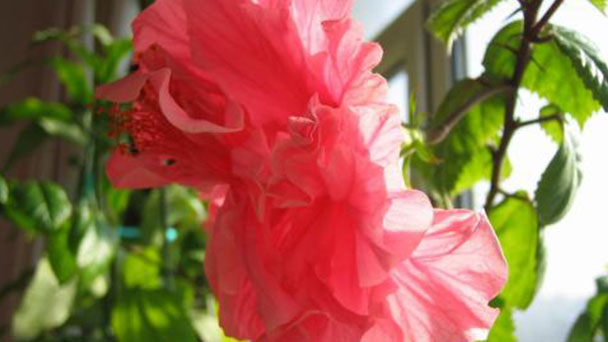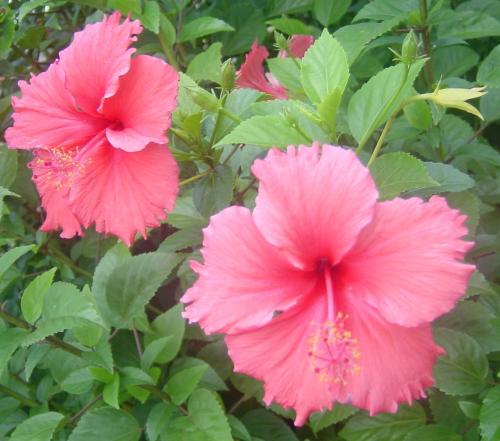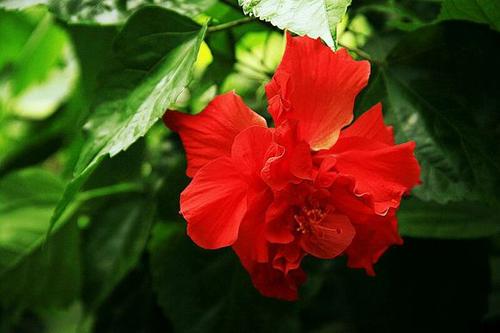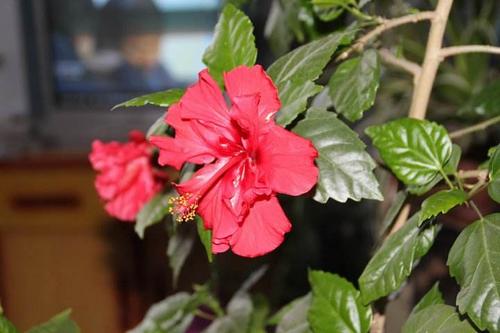Rose of Sharon profile
Written by Maggie
Jan 14 2021

The Rose of Sharon , scientific name, hibiscus syriacus, scientific name Hibiscus syriacus, is very colorful and very beautiful, with large and complete flowers, dry, white color without impurities for the best. The Rose of Sharon is an excellent plant for freestyling flower hedges, suitable for the layout of both sides of the road, parks, courtyards and other places, and can be isolated planting, planting or planting. Rose of Sharon flowers can also be used as a traditional Chinese medicine and can be eaten.
Rose of Sharon picture

Morphological characteristics of Rose of Sharon flowers
The flowers of Rose of Sharon (hibiscus syriacus) are irregularly shaped, 1.5 -- 3cm long, 1 -- 1.5cm wide, obtuse at the base, short stalk, and round bracts. The calyx is gray-green, lobes indented or anti curling; Pedicle, bract and calyx have fine hairs; The Rose of Sharon has 10 petals, wrinkled, yellowish or lavender blue, obovate, base densely white pubescent; Stamens are combined into a stamen column, anther majority, purple black. The gas is light and the taste is light.
Rose of Sharon (hibiscus syriacus) flowers are deciduous shrubs; Ovate leaves are often trifid, with three veins, flowering in summer and autumn, the flowers are solitary and axillary, bell-shaped, about 4 to 10 cm in diameter. The whole plant can be 2 to 4 meters tall. The flowering season is from July to September. One flower blooms only for a day. It blooms in the morning, and dies in the evening. The flower blooms one after another and lasts so long that it is called the infinite flower in Korea.
Rose of Sharon (hibiscus syriacus) is a deciduous shrub or small tree; 3 ~ 5 m high, much branched; Leaves are triangular or rhombic ovate, sometimes 3-lobed above middle. Large flowers, axils of single leaves, 5 to 8 cm in diameter, single or double, white, pink, purple and other colors, sometimes red or purple petals at the base; A lot of flowers, although each flower only open a day, but every day there are a lot of flowers open, very beautiful.
Flowers of Rose of Sharon (hibiscus syriacus) are compact, ovate or cylindrical, ca. 3 cm long, ca. 1.5 cm in diameter. The bottom has grayish green calyx, the surface is densely born fine tomentose, margin 5 lobes. Outside the calyx there are several grayish-green linear bracts, often with short flower stalks. Petals white, 5 or many laminated, contracted curls.There are yellow stamens in the middle, and most stamens are combined into cylinders, surrounded by pistil. Rose of Sharon is light in quality, slightly fragrant, sweet in taste. The flower is large and the color is white. Flowers are irregularly shaped, base obtuse, stalk short, bracts round. Calyx is grayish green, lobes indented or anti curling; There are fine hairs outside stalk, bract and calyx. Petals 10, wrinkled, color is yellowish or lavender blue, obovate, the base is densely white pubescent; Stamens are combined into a stamen column, anther majority, purple black. The smell is light and the taste is light.
Rose of Sharon: flowering from June to October, fruiting from September to October.
The ecological habits of Rose of Sharon
Rose of Sharon flowers (hibiscus syriacus) like warm cool, wet, sunny climate conditions, like fertile neutral to slightly acidic soil, drought resistance, barren resistance, semi-shade resistance, waterlogging, cold resistance, suitable temperature for growth 15 ~ 28℃.
Rose of Sharon (hibiscus syriacus) prefers full sun and slightly shade tolerant. They like warm, moist and cold resistant, and can survive the winter safely in the open in most areas of North China. Rose of Sharon is pleasant with fertile loose, good drainage soil. Rose of Sharon rrought resistance is thin and waterlogging resistance is also weak.
The origin of Rose of Sharon
The genus Rose of Sharon (hibiscus syriacus) is mainly distributed in tropical and subtropical regions. The species of the genus Rose of Sharon originated from the African continent. There are many species of the genus Rose of Sharon in Africa, showing rich genetic diversity. In addition, wild types of this species are also found in Southeast Asia, South America, Australia, and Central America. China is also home to some Rose of Sharon species.

Growing management of Rose of Sharon
Rose of Sharon has strong adaptability, simple cultivation, extensive management, and generally can be allowed to grow freely. However, in order to improve its ornamental effect and make its flowers colorful, it should be given necessary management.
Rose of Sharon (hibiscus syriacus) blooms on current shoots and can be pruned properly after falling leaves in the autumn. Trim opportune and opportune dredge cut and shortcut photograph union, right long branch moderate shortcut, sparse had been to dense branch, fine weak branch, make nutrition concentration, plump.In the middle of April, late spring after the germination of the plant, should be applied 1 times of fertilizer, and real-time watering, to ensure that the soil of fertilizer and water is sufficient.
When planting Rose of Sharon, base fertilizer should be applied to the planting hole, and no fertilizer should be applied in the future. Before spring bud germination to summer flowering period, see the weather irrigation 2 ~ 3 times.In the rainy season, drainage is needed to prevent waterlogging. After autumn frost before irrigation a previous frost. Late summer and early autumn should not be irrigation, so as not to fall shoot growth too tender and reduce cold resistance. 5 ~ 6 years of seedling overwintering, should be taken to prevent cold measures, such as root soil, etc.
Water management
When the branches start to germinate, it should be timely topdressing, with quick-effect fertilizer, to promote nutritional growth; Topdressing phosphorus and potassium fertilizer before budding bud to promote bud pregnancy; During the flowering period, the combination of weeding and soil raising was used for topdressing, with phosphorus and potassium fertilizer as the main fertilizer, supplemented by nitrogen fertilizer, to maintain the flower quantity and tree potential. During the dormancy period in winter, weeding and clearing the garden are carried out. Ditches or holes are dug around the plants to fertilize them. The main fertilizer is farmhouse fertilizer, supplemented by an appropriate amount of inorganic compound fertilizer, so as to supply nutrients needed for growth and flowering in the coming year. In long-term dry weather, we should pay attention to irrigation, and excessive rain to drainage waterlogging prevention.
The plastic clip
Newly planted Rose of Sharon (hibiscus syriacus) plants are small, they can be allowed to grow in the first 1-2 years or light pruning, that is, in the fall and winter to remove dead branches, weak insects, fading branches. After the tree grows, the Rose of Sharon plant should be reshaping and pruning. Shaping and pruning should be carried out after the fall leaves. The pruning mouth should be smeared with callus anticorrosive film to prevent the invasion of pathogen infection.
Strong promote flower buds
In the next year, all the flourishing and strong flowering branches were thinned, and the middle and short flowering branches were left. The perennials with thin inner cavities were continuously retracted and renewed. The middle and small flowering branches were cut short, which could effectively adjust the branch potential. Combine spray on flowers to strengthen tilling and strengthen buds.
Rose of Sharon diseases and pests prevention
During the growth of Rose of Sharon (hibiscus syriacus), there were few diseases and insect pests, and diseases mainly included anthrax, leaf blight, powdery mildew, etc. The main pests are red spider, aphid, demoiselle moth, night moth, longicorn and so on. When pests and diseases occur, pests and diseases can be cut off, and safe, efficient and low toxic pesticide spray combined with spray of new high fat film is used to enhance the efficacy of prevention and control. Attention should be paid to early control, avoid in the flowering and harvest period, to ensure that the Rose of Sharon flowers collected are not contaminated by pesticides.
Main values of Rose of Sharon
1. Ornamental effect. Rose of Sharon blooms in summer and autumn, with a long flowering period and many varieties of patterns and shapes. It is an excellent garden flower tree species. It’s often used as hedges and base planting material. Rose of Sharon is suitable for planting on lawns, roadsides or forest margins, or as hedges or in combination with other plants. Because its branches are soft and resistant to pruning, it can be modeled to make a pile scene or potted. At the same time, it also has strong resistance, and is also an excellent plant greening.
2. Medicinal value. Rose of Sharon can clear lungs and dissolve phlegm, detoxify pain, treat phlegm asthma cough, nerve headache, yellow water sores.
3. Edible value. In the Tingzhou area of Fujian Province, Rose of Sharon flower is made by mixing noodles with Rose of Sharon flower and then adding oil to make the fried Rose of Sharon flower. The flower shape is faintly existing, and the color, fragrance and taste are all perfect. It is called "noodle flower", which is a delicacy on flower banquets. The famous Rose of Sharon Tofu Soup in Huizhou, Anhui Province, is made by boiling Rose of Sharon flowers and tofu together. It is fragrant and delicious. The tofu is fresh and tender. Rose of Sharon is a kind of natural health food, which is easy to make as a vegetable and can be used for salad, stir-frying and soup. Its texture is crisp and tender, fine and smooth and delicious, and its taste is fragrant. It can moisten dry and remove moisture and heat.
Rose of Sharon flower language
Tenacity, eternal beauty, gentle persistence.

Latest Updated
- Benefits of Bugleweed - 7 Science-backed Health Benefits
- Bugleweed Dangers & Side Effects - Is It Poisonous?
- How to Plant Evergreen Trees - What You Should Know
- When to Plant Evergreens - Grow Guide for Evergreen Trees
- 12 Wonderful Evergreen Shrubs for Your Garden
- 12 Popular Evergreen Plants with Pictures for Beginners
- When And How To Prune A Lilac Bush Like a Pro
- How to Grow & Care for Lilac Vine (Hardenbergia Violacea)
- Japanese Lilac Tree (Syringa Reticulata) Care & Propagation Guide
- Shumard Oak Pros and Cons - What to Know
Popular Articles
- Winter maintenance of Antirrhinum Majus
- How to Grow Terminalia Mantaly Tree
- How to Grow and Care for Crossostephium Chinense
- How to grow Antirrhinum Majus in spring
- Peristeria Elata (Dove Orchid) Profile: Info & Care Guide
- Underwatered Snake Plant (Sansevieria Trifasciata) - Signs And How To Fix
- How to Care for Brazilian Jasmine Plant (Mandevilla Sanderi)
- How to Grow & Care for Graptopetalum Purple Delight in Summer
- Rosa Chinensis (China Rose): Plant Growing & Care Tips
- How to Care for Baby Sun Rose (Aptenia Cordifolia)